|
|
|
Sort Order |
|
|
|
Items / Page
|
|
|
|
|
|
|
| Srl | Item |
| 1 |
ID:
173788
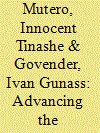

|
|
|
|
|
| Summary/Abstract |
This article frames a discussion on how South African universities and communities can co-create university spaces that facilitate repairing the country’s dented social, economic and political infrastructure through engaged creative-placemaking. The first section further explores the concept followed by a discussion of historical issues which have a material bearing on how universities can and should frame community engagement in South Africa. It pays close attention to how post-apartheid nation building is hindered by the remnants from the past and is dislocated to both the present and the future. The article also brings into question the type and role of leadership, in both universities and communities. The final section of the article presents a framework for engaged creative-placemaking delineating the antecedents that are needed by the key stakeholders, namely, public and private enterprises, university and the community to successfully work together in achieving a just society through creative-placemaking. Improving place liveability through engaged creative-placemaking has the potential to stimulate local economies and leads to cultural diversity, civic engagement and increased innovation.
|
|
|
|
|
|
|
|
|
|
|
|
|
|
|
|
| 2 |
ID:
184667
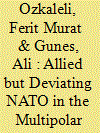

|
|
|
|
|
| Summary/Abstract |
“How long can NATO last in a post-US hegemonic, multipolar world?” has become an important question in contemporary world politics. By statistically analyzing NATO alliance cohesion since its inception, this analysis contributes to the literature by developing an original set of indicators that rely on the ideal point estimates from a recent UN General Assembly voting dataset. It empirically verifies that NATO members have higher cohesion than other UN members, although the United States has been the most significant deviating member since 1980. The findings support some earlier proposals such as the external threat hypothesis. They also contradict some others, notably the literature on the Donald Trump administration’s withdrawal doctrine, and the decline of US hegemony and its policy implications. The article concludes that the future challenge for NATO cohesion not only would be the possibility of US abdication or abandonment, but also other members’ balancing the United States as the hegemon.
|
|
|
|
|
|
|
|
|
|
|
|
|
|
|
|
| 3 |
ID:
131895
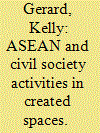

|
|
|
|
|
| Publication |
2014.
|
| Summary/Abstract |
The Association of Southeast Asian Nations (ASEAN) has recently made numerous commitments to engage civil society organizations (CSOs) in its governance practices. However, the opportunities created offer limited means for CSOs to contest policy as a result of strict controls over who can participate and the forms of participation permitted. Activists have consequently pursued their agendas outside of spaces sanctioned by ASEAN through 'created spaces,' such as conferences organized parallel to official summits. However, this form of political participation has limited potential to influence official processes because despite its independence, these activities are still structured in relation to ASEAN practices. The ineffectual nature of CSO advocacy despite ASEAN's people-orientated shift has been documented, however explanations for this trend remain limited. This article applies the modes of political participation framework that acknowledges the role of intergovernmental organizations in structuring spaces for civil society participation and, in doing so, shaping the contribution that CSOs can make. Through an examination of the regulations and practices that govern CSO participation in both ASEAN-sanctioned and independent spaces, it argues that spaces for CSO participation are structured to prevent CSOs from contesting policy, suggesting that ASEAN's shift to widen participation is directed towards legitimating its reform agenda. Hence, ASEAN's claim of becoming 'people oriented' must be considered in recognition of the limiting effect its engagement practices have on CSOs' ability to advance alternative agendas.
|
|
|
|
|
|
|
|
|
|
|
|
|
|
|
|
| 4 |
ID:
092378
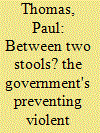

|
|
|
|
|
| Publication |
2009.
|
| Summary/Abstract |
The 7/7 London suicide bombings of July 2005 and numerous subsequent Islamist terror plots have highlighted the reality of an 'internal' threat to Britain. One governmental response has been the 'Preventing Violent Extremism' (PVE) programme. Whilst the educational aspect of its focus on Muslim young people is to be welcomed, there are serious concerns as to whether PVE policy, as currently designed, is falling between two stools. To date, the programme focuses exclusively on Muslim communities in flat contradiction to the integration policy priority of community cohesion, so risking further defensiveness from Muslim communities and resentment from white working class communities. Whilst ignoring the right-wing extremism growing in some of those white communities, PVE work with young people is actually failing to engage openly and robustly with the real political issues driving Muslim anger and minority extremist support. The confidence, understanding and skills of educational practitioners are vital here.
|
|
|
|
|
|
|
|
|
|
|
|
|
|
|
|
| 5 |
ID:
178357
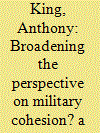

|
|
|
|
|
| Summary/Abstract |
In 2018, Ilmari Käihkö published a special collection in Armed Forces & Society on the debate about small unit cohesion. Later, in reaction to a response by Guy Siebold, he published a further intervention with Peter Haldén. Focusing on my 2006 article in the journal and my subsequent debate, Käihkö has claimed that the cohesion debate is too narrow. It ignores organizational factors in the armed forces and wider political factors, including nationalism and state policy. Consequently, it is incapable of analyzing non-Western state or irregular forces and is only relevant for the 20th and 21st centuries. This response shows that while Käihkö’s extension of the empirical archive to non-Western armed groups is to be welcomed, none of his theoretical claims are sustainable.
|
|
|
|
|
|
|
|
|
|
|
|
|
|
|
|
| 6 |
ID:
165026
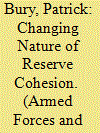

|
|
|
|
|
| Summary/Abstract |
For too long military cohesion scholars have focused on regular infantry forces. This article examines the impact of the Future Reserves 2020 (FR20) policy on cohesion, professionalism, and discipline among British reserve logisticians. In doing so, it makes three significant contributions to the cohesion literature. Firstly, addressing scholars’ almost exclusive focus on regular infantry, it presents the first academic study on cohesion in British reserve logistics forces. Secondly, in detailing how cohesion in these forces is based on interpersonal rather than professional bonds, it argues that the locus of cohesion and discipline in these forces is different to that recently identified in the regular professional infantry. Thirdly, the article argues that while FR20 is gradually changing many of British reserve norms, the organizational realities of reserve service continue to limit the policy's impact. The evidence presented may be theoretically applicable to other reserve and noncombat forces in future cohesion research.
|
|
|
|
|
|
|
|
|
|
|
|
|
|
|
|
| 7 |
ID:
173130
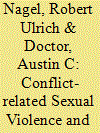

|
|
|
|
|
| Summary/Abstract |
To what extent does sexual violence influence rebel group fragmentation? A substantial body of research explores wartime rape as a cohesion-building mechanism following forced recruitment. However, the relationship between sexual violence and broader organizational structural integrity has not been systematically tested. Our study on the effects of sexual violence on rebel group fragmentation provides this test. We argue that sexual violence increases cohesion at the battalion level but increases the risk of fragmentation of the broader organization because lieutenants are more likely to split from organizations if they are confident that their subordinate battalions are cohesive and will follow them. We test this argument on a global sample of 105 rebel organizations active between 1989 and 2014. The results provide robust support for the argument showing sexual violence increases the probability of fragmentation by a factor of six. This presents a crucial contribution to our understanding of sexual violence and rebel group fragmentation.
|
|
|
|
|
|
|
|
|
|
|
|
|
|
|
|
| 8 |
ID:
106058
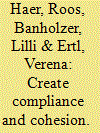

|
|
|
|
|
| Publication |
2011.
|
| Summary/Abstract |
Established conflict theories focus on the role of incentives in the decision to join, stay, or leave an insurgency. These theories, however, disregard the pressure that an organization can impose on its members. Similar to legal organizations, we assert that a rebel organization can sustain itself by effective human resource management. Using narratives resulting from psychological trauma therapy of former combatants of the Lord's Resistance Army (LRA), these management strategies are examined. The analysis shows that the LRA sustains itself in the first place by the use of brute force. However, they also manage themselves by a careful selection process of their fighters, by the conscious creation of social control, and by offering their members an alternative social network in which promotion and compensation play a role.
|
|
|
|
|
|
|
|
|
|
|
|
|
|
|
|
| 9 |
ID:
109209
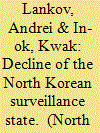

|
|
|
|
|
| Publication |
2011.
|
| Summary/Abstract |
One of the peculiarities of the North Korean system is the cohesive nature of state surveillance. This surveillance operates through two major channels: at his/her job a North Korean is controlled by the "organization," and in his/her place of residence surveillance is done by the "people's group." This article, based on the refugees' testimony and available publications, traces the origin and the types of surveillance used by the "people's groups." Nonpolitical activities of the "people's groups" are discussed as well. Finally, the article traces how the "people's groups" have changed in the last two decades as state control began to disintegrate.
|
|
|
|
|
|
|
|
|
|
|
|
|
|
|
|
| 10 |
ID:
143320
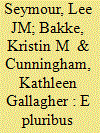

|
|
|
|
|
| Summary/Abstract |
Why are some ethnopolitical movements divided while others are relatively unified? A growing literature examines the consequences of internal divisions in ethnopolitical movements – and shows that it matters for a range of conflict outcomes – yet the mechanisms causing such divisions remain poorly understood. Our argument emphasizes competitive dynamics between states and self-determination movements and between rival factions within these movements as key determinants of fragmentation. Drawing from literatures on social movements, contentious politics, and civil war, we situate our argument vis-à-vis three alternative and complementary sets of explanations based on theories emphasizing transnational dimensions, political institutions, and structural factors within ethnopolitical groups. Using an original dataset, we test hypotheses explaining movement fragmentation over time and use a case study of Punjab in India to identify specific causal mechanisms and missing variables. Our findings show some support for three of these theories, suggesting that ethnopolitical movements divide as a result of complex and interactive processes. But our findings also underscore that central to explaining fragmentation dynamics are factors capturing competitive dynamics, including repression, accommodation of movement demands, the turn to violence, and the dynamic and changing nature of ethnopolitical demands.
|
|
|
|
|
|
|
|
|
|
|
|
|
|
|
|
| 11 |
ID:
088940
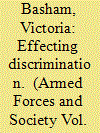

|
|
|
|
|
| Publication |
2009.
|
| Summary/Abstract |
In recent years, the British military has introduced a number of policies aimed at recruiting and sustaining demographically diverse armed forces. Central to these is a "zero-tolerance" approach to discrimination and harassment. However, by undertaking an "effective" reading of policies aimed at managing sexual orientation and gender diversity, and by drawing on qualitative research with members of the British forces, this article demonstrates how the military's own implementation strategies facilitate discrimination against some recruits. It concludes that although the British military is understandably keen to protect its operational effectiveness, by clinging to unreflexive claims about the nature of social cohesion, and in failing to respond to societal demands for inclusion, military officials are undermining the social legitimacy of the armed forces. By extension, they are destabilizing, rather than protecting, their capabilities
|
|
|
|
|
|
|
|
|
|
|
|
|
|
|
|
| 12 |
ID:
162509
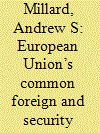

|
|
|
|
|
| Summary/Abstract |
The European Union (EU) is at a turning point. With the bipolar order of the Cold War fast becoming a distant memory, the European Union must quickly establish itself on the global stage before it loses the opportunity to do so. With Northeast Asia fast emerging as a new economic giant and political center for world affairs, the EU must reform its Common Foreign and Security Policy in order to develop a reputation and image as a global actor of soft power, based on its long-standing values and peaceful diplomacy. However, despite major reforms in the Lisbon Treaty (2009), the EU has not been able to form cohesion amongst its members, thus hindering its progress in achieving such international recognition. This paper therefore analyses the reforms taken place so far and suggests further reforms that will build a strong foundation for a united and cohesive foreign policy. It will then look at how the reformed framework will allow the EU to establish itself as a global actor in political affairs, in particular in Northeast Asia.
|
|
|
|
|
|
|
|
|
|
|
|
|
|
|
|
| 13 |
ID:
160872
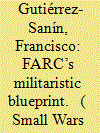

|
|
|
|
|
| Summary/Abstract |
This article intends to explain the outstanding sequence of success and failure exhibited by the FARC, the main Colombian guerrilla since the 1980s. It claims that such sequence is unintelligible unless the adoption by the FARC of a militaristic organizational blueprint at its 1982 7th Conference is taken into account. By building itself like an army, the FARC could boost its combat capacity, maintain its structural integrity, and develop powerful mechanisms that held the whole structure together. At the same time, the militarization of the FARC also entailed significant risks and costs like political isolation and high personnel turnover. After describing the militaristic blueprint, the article compares the FARC with other irregular forces that operated in the Colombian context – a comparison which is important to understand the specificity of the FARC trajectory, as well as the benefits and costs involved in it. The analysis highlights the critical role of organizational dimensions in the explanation of civil war outcomes, and suggests that at least for some problems organizational dynamics should be observed at a low level of granularity.
|
|
|
|
|
|
|
|
|
|
|
|
|
|
|
|
| 14 |
ID:
173124
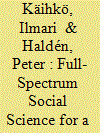

|
|
|
|
|
| Summary/Abstract |
In October 2018, Armed Forces & Society published a special issue dedicated to broadening the perspective on military cohesion from the narrow focus on 20th and 21st Western state militaries and the microlevel. The special issue emphasized the need for a theoretical and methodological broadening of the study of cohesion: In order to understand the majority of armed groups in the world, it is necessary to investigate macro- and mesolevel preconditions of microlevel cohesion. Such preconditions include the existence of states, nations, and modern military organization. These are specific to modern, Western contexts, and rarely feature in historical or non-Western cases. In many cases, investigating these preconditions requires qualitative methods. In a critical response, Siebold contested some of the arguments of the special issue, claiming that our argument was exaggerated and our methodologies inadequate. In this reply, we seek to clarify some of the issues and arguments at stake.
|
|
|
|
|
|
|
|
|
|
|
|
|
|
|
|
| 15 |
ID:
161523
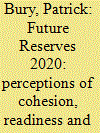

|
|
|
|
|
| Summary/Abstract |
The British Army Reserve, and in particular its logistics component, is currently undergoing profound organisational transformation as part of the Future Reserves 2020 (FR20) program. Yet, to date there has been no sustained quantitative analysis of perceptions of cohesion, readiness and morale in the Army Reserve. Moreover, there has been little quantitative examination of FR20’s impact to date. This paper addresses these gaps in the literature by undertaking an examination of the above variables using survey data from a representative sample of AR logistics soldiers collected longitudinally. It finds that cohesion is highly important in explaining variance in perceptions of readiness and morale, and that perceptions of cohesion, readiness and morale are relatively high in the force. Nevertheless, the data indicates that FR20 has failed to increase these significantly over time. Similarly, it finds that confidence in FR20 delivering increased military capability is also declining. These findings are important for understanding FR20’s impact to date and future trajectory.
|
| Contents |
The British Army Reserve, and in particular its logistics component, is currently undergoing profound organisational transformation as part of the Future Reserves 2020 (FR20) program. Yet, to date there has been no sustained quantitative analysis of perceptions of cohesion, readiness and morale in the Army Reserve. Moreover, there has been little quantitative examination of FR20’s impact to date. This paper addresses these gaps in the literature by undertaking an examination of the above variables using survey data from a representative sample of AR logistics soldiers collected longitudinally. It finds that cohesion is highly important in explaining variance in perceptions of readiness and morale, and that perceptions of cohesion, readiness and morale are relatively high in the force. Nevertheless, the data indicates that FR20 has failed to increase these significantly over time. Similarly, it finds that confidence in FR20 delivering increased military capability is also declining. These findings are important for understanding FR20’s impact to date and future trajectory.
|
|
|
|
|
|
|
|
|
|
|
|
|
|
|
|
| 16 |
ID:
124789
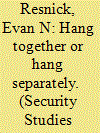

|
|
|
|
|
| Publication |
2013.
|
| Summary/Abstract |
Neorealist and liberal theories advance discrepant explanations for variations in wartime alliance cohesion. Neorealism claims that variations in cohesion are attributable to shifting international systemic conditions; liberalism argues that such differences are a function of the regime type(s) of the various alliance partners. I advance a synthetic neoclassical realist theory that proposes a given ally's decision to minimize or maximize cohesion is a function of both international systemic conditions and the regime type of the state in question. I test the three theories in US, British, and Soviet alliance decision making during World War II and find that neoclassical realism alone accounts for the behavior of all three partners over the lifespan of the "Grand Alliance" (January 1942-September 1945). The article concludes by discussing the implications of these findings for the study and practice of alliance politics, as well as for contemporary US foreign policy
|
|
|
|
|
|
|
|
|
|
|
|
|
|
|
|
| 17 |
ID:
190934
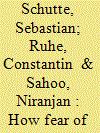

|
|
|
|
|
| Summary/Abstract |
Earlier research on ethnic and religious conflict has identified fear as an important motivation. While theoretically sound, this expectation has never been tested at larger scales in ongoing episodes of political violence. Instead, conceptual progress has been made in lab experiments. Combining insights from observational research and stylized experiments, we predict that fear for personal safety due to witnessed violence causes prejudice against out-groups, enhanced internal cohesion, and support for extremist actors. To test these predictions, we conducted surveys in the Indian State of Uttar Pradesh with identical respondents in three waves starting in January 2017. The surveys continued during the tense Legislative Assembly elections in the Spring. The results largely corroborate the theoretical expectations and present a hard in-vivo test of long-standing conjectures.
|
|
|
|
|
|
|
|
|
|
|
|
|
|
|
|
| 18 |
ID:
186100
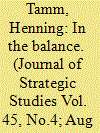

|
|
|
|
|
| Summary/Abstract |
The two main rebel groups in the Second Congo War (1998–2003) evolved in remarkably different ways. While the MLC maintained organisational cohesion throughout the war, the RCD split into two rival groups within less than a year. The larger of these rivals then remained cohesive, whereas the smaller group experienced further fragmentation. This article draws on interviews with key protagonists to show that these cross-group differences resulted from different patterns of state sponsorship. Fragmentation occurred when the intra-group distribution of power between a rebel leader and an internal rival hung in the balance because external troops supported both sides.
|
|
|
|
|
|
|
|
|
|
|
|
|
|
|
|
| 19 |
ID:
092932
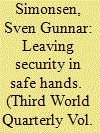

|
|
|
|
|
| Publication |
2009.
|
| Summary/Abstract |
Built by outside powers and targeted against local insurgents, the new national armies of Afghanistan and Iraq are fragile institutions. The legitimacy of these forces is limited in the deeply divided societies in which they exist. Whereas low levels of legitimacy exert a disintegrative pressure upon an army, cohesion counterweighs such pressure. This article engages the theory of military unit cohesion for the purpose of increasing understanding of the challenges to cohesion faced by the new armies of Afghanistan and Iraq. Two main sources of legitimacy for the new armies are discussed: the (ethnic/sectarian) composition of the forces, and their respective missions. Challenges to cohesion are found to depend on how soldiers are recruited and units composed: ethnically/sectarian mixed units may disintegrate because of weak horizontal cohesion; homogeneous units (particularly when recruited as groups and not individually) may splinter off because of weak vertical cohesion. The article also argues that promoting an image of the army as 'national' within a society may reduce disintegrative pressures.
|
|
|
|
|
|
|
|
|
|
|
|
|
|
|
|
| 20 |
ID:
178351
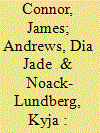

|
|
|
|
|
| Summary/Abstract |
Loyalty between soldiers is idealized as an emotion that promotes cohesion and combat effectiveness. However, little empirical work has examined how military personnel understand, feel, and enact loyalty. We use a symbolic interactionalist informed frame to explore the lived experience of 24 retired Australian Defence Force members via in-depth semi-structured interviews. Our analysis revealed three core themes: (1) Loyalty as reciprocity, where there was an expectation that loyalty would be returned no matter what. (2) The importance of emotional connection for cohesion. (3) Loyalty as a prioritizing process, where a soldier’s loyalties gave them a way of choosing between competing demands. Loyalty is a moral emotion that enabled sensemaking. Close interpersonal loyalties tended to trump wider/diffused loyalties. Respondents understood their loyalties to fellow soldiers within wider social constructs of mateship and professionalism. The findings show the risks that come from a reliance on loyalty for combat cohesion.
|
|
|
|
|
|
|
|
|
|
|
|
|
|
|
|
|
|
|
|
|